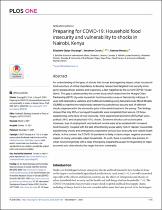| dc.contributor.author | Onyango, Elizabeth Opiyo | |
| dc.contributor.author | Crush, Jonathan | |
| dc.contributor.author | Owuor, Samuel | |
| dc.date.accessioned | 2022-07-25T10:59:56Z | |
| dc.date.available | 2022-07-25T10:59:56Z | |
| dc.date.issued | 2021 | |
| dc.identifier.citation | Onyango, E. O., Crush, J., & Owuor, S. (2021). Preparing for COVID-19: Household food insecurity and vulnerability to shocks in nairobi, kenya. PLoS ONE, 16(November) doi:10.1371/journal.pone.0259139 | en_US |
| dc.identifier.issn | 19326203 | |
| dc.identifier.uri | 10.1371/journal.pone.0259139 | |
| dc.identifier.uri | http://hdl.handle.net/10566/7624 | |
| dc.description.abstract | An understanding of the types of shocks that disrupt and negatively impact urban household food security is of critical importance to develop relevant and targeted food security emergency preparedness policies and responses, a fact magnified by the current COVID-19 pandemic. This gap is addressed by the current study which draws from the Hungry Cities Partnership (HCP) city-wide household food insecurity survey of Nairobi city in Kenya. It uses both descriptive statistics and multilevel modelling using General Linear Mixed Models (GLMM) to examine the relationship between household food security and 16 different shocks experienced in the six months prior to the administration of the survey. The findings showed that only 29% of surveyed households were completely food secure. Of those experiencing some level of food insecurity, more experienced economic (55%) than sociopolitical (16%) and biophysical (10%) shocks. Economic shocks such as food price increases, loss of employment, and reduced income were all associated with increased food insecurity. Coupled with the lack of functioning social safety nets in Nairobi, households experiencing shocks and emergencies experience serious food insecurity and related health effects. In this context, the COVID-19 pandemic is likely to have a major negative economic impact on many vulnerable urban households. As such, there is need for new policies on urban food emergencies with a clear emergency preparedness plan for responding to major economic and other shocks that target the most vulnerable. Copyright: © 2021 Onyango et al. This is an open access article distributed under the terms of the Creative Commons Attribution License, which permits unrestricted use, distribution, and reproduction in any medium, provided the original author and source are credited. | en_US |
| dc.language.iso | en | en_US |
| dc.publisher | Public Library of Science | en_US |
| dc.subject | COVID-19 pandemic | en_US |
| dc.subject | Food security | en_US |
| dc.subject | General Linear Mixed Models | en_US |
| dc.subject | Hungry Cities Partnership | en_US |
| dc.title | Preparing for COVID-19: Household food insecurity and vulnerability to shocks in Nairobi, Kenya | en_US |
| dc.type | Article | en_US |

